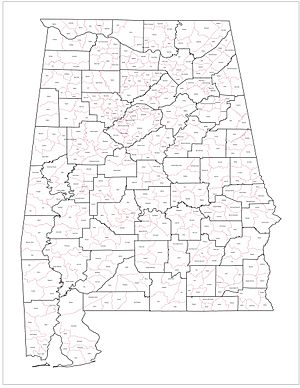List of census county divisions in Alabama facts for kids
The state of Alabama is divided into 67 counties. These counties are then split into smaller areas called census county divisions (CCDs). Think of a CCD as a special statistical zone. These zones are created by the Census Bureau along with state and local governments. They are used to help count people and gather important information about communities.
Contents
What are Census County Divisions?
A Census County Division (CCD) is like a smaller neighborhood or area within a county. These divisions are used for collecting information about where people live. They are "relatively permanent," meaning they don't change very often. This helps the Census Bureau track population changes over time.
Why Does Alabama Use Them?
Some states have official local government areas like townships. These townships have their own local governments and clear boundaries. However, Alabama does not have these types of well-defined townships. Because of this, the Census Bureau created CCDs for Alabama. These CCDs help organize the state for census purposes, making it easier to collect accurate data. Alabama has 390 of these census county divisions.
How Census Divisions Help Us
These divisions are very important for understanding where people live and how communities are growing. The information collected using CCDs helps local and state governments plan for things like schools, roads, and other services. For example, if a CCD shows a lot of new families moving in, the local government might need to build a new school or expand existing ones. They also help researchers and businesses understand different areas better.
Examples of Census County Divisions
Many towns and cities in Alabama are part of these census county divisions. Sometimes, a division is named after one main town, like Anniston. Other times, a division might include a few smaller towns or areas grouped together, like Albertville-Boaz. Here are just a few examples of these divisions across Alabama:
These divisions help create a clear picture of Alabama's population, even in areas without formal local government boundaries.


